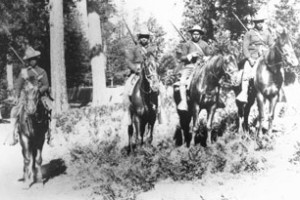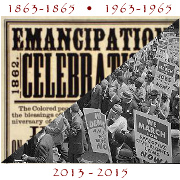Buffalo Soldiers in the National Parks Study Act
Posted June 19th, 2013 by James DeWolf PerryCategory: Public History Tags: Buffalo Soldiers, Jim Crow, National Park Service, U.S. Army
 On Monday, the U.S. House of Representatives passed H.R. 520, the “Buffalo Soldiers in the National Parks Study Act,” which would study ways for the National Park Service to commemorate these black troops and their historic role in the post-Civil War era.
On Monday, the U.S. House of Representatives passed H.R. 520, the “Buffalo Soldiers in the National Parks Study Act,” which would study ways for the National Park Service to commemorate these black troops and their historic role in the post-Civil War era.
The history of the Buffalo Soldiers
The Buffalo Soldiers were U.S. Army troops who, as the bill puts it, “served in many critical roles in the western United States, including protecting some of the first National Parks” in the Sierra Nevada. Their origins date to 1866, when Congress authorized the creation of all-black Army regiments: the 24th and 25th infantry regiments and the 9th and 10th cavalry regiments. The soldiers who enlisted were primarily southerners leaving behind sharply limited economic opportunities for black citizens in the Jim Crow South. The Buffalo Soldiers performed many duties in the West, including service in the Spanish-American and Indian Wars and patrolling large territories to maintain law and order.
In hindsight, the Buffalo Soldiers have also come to be seen as the nation’s first park rangers. Some 500 Buffalo Soldiers were assigned to Yosemite and Sequoia national parks, performing what would later become traditional duties of park rangers, including fighting forest fires, seizing illegal firearms, and patrolling for poachers and natural-resource thieves.
The history of the Buffalo Soldiers includes severe racism. As with Pullman porters and other prominent, progressive jobs held by black Americans during this period in history, serving as a Buffalo Soldier was simultaneously one of the most prestigious jobs available to black Americans, and one in which racial prejudice required exceedingly careful and deferential behavior. Buffalo Soldiers lacked the authority of their white counterparts in the Army, making their jobs far more challenging, and were frequently abused, and sometimes even killed, on the slightest pretext.
The term “Buffalo Soldiers” is believed to derive from the belief of the Cheyenne and other Native Americans that their hair resembled the matted tuft between the horns of the buffalo.
Why commemorate the Buffalo Soldiers in our national parks?
While the commemoration of the Buffalo Soldiers serves to illuminate the history of African-American military service in the years after the Civil War, H.R. 520 is also motivated by a desire to tell the early history of what became the National Park Service. Finally, it is also intended, in the words of Ron Sundergill of the National Parks Conservation Association, to “celebrate the centennial” of the park service in 2016 “by diversifying our national parks so that they reflect all of our cultural heritages.”
Ranger Shelton Johnson, who interprets park history at Yosemite, speaks bluntly about the importance of racial and ethnic diversity for the national parks:
Many African-Americans don’t feel a cultural connection to the national parks because they don’t feel a connection to the history.
It’s good for the entire country to know that people of color and women made contributions to our parks.
The legislation
H.R. 520, sponsored by Rep. Jackie Speier (D-Calif.), would have the U.S. Interior Department study ways to commemorate and interpret the role of the Buffalo Soldiers in the early years of our nation’s national parks, in particular, prior to the establishment of the National Park Service.
This study would evaluate the possibility of a national historic trail to commemorate the route of the Buffalo Soldiers from San Francisco’s Presidio, where they were based, to Sequoia and Yosemite National Parks, which would amount to a route of about 280 miles. Other issues studied would include properties which would be designated at National Historic Landmarks or listed on the National Register of Historic Places, and other ways to conduct historic research and to provide education and interpretation and to increase public awareness of the history of the Buffalo Soldiers.
The bill now moves on to the Senate, where parallel legislation, S. 225, was introduced earlier this year by Sen. Dianne Feinstein (D-Calif.).



October 14th, 2013 at 1:25 pm
As a family of descendants of Buffalo Soldier Sgt. Matthew McKinley Garnette (Fredericksburg, VA), we have just begun to inquire about having my great-grandfather's home-site recognized as a historical landmark for city education / tours. Thank you for posting this article, I will continue to follow the progress.